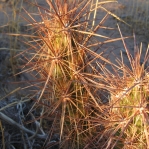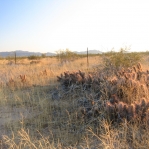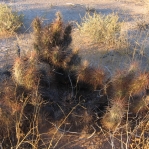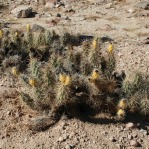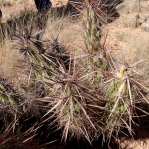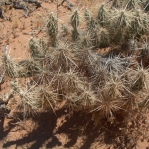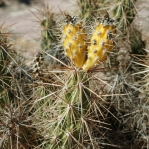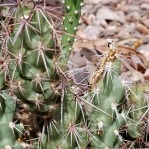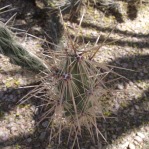JN Rose, Smithsonian Miscellaneous Collections 50(4): 505–506. 1908
Herbarium specimen; Herbarium specimen; Herbarium specimen; Herbarium specimen; Herbarium specimen; Herbarium specimen; Herbarium specimen; Herbarium specimen; Herbarium specimen; Herbarium specimen; Herbarium specimen
Original Description
SEINet Portal
What is Grusonia kunzei?
Grusonia kunzei is a dog cholla found in southwestern Arizona. It is a large plant for Grusonia, sometimes making thickets meters across.
Details
G. kunzei forms mats, to 50 cm, in series of usually 2-4 stem segments. The roots are diffuse. The stem segments may be modestly curved and narrowed at base, 10-15 × 2.5-4 cm. The tubercles are prominent, 20-30 mm long and narrow, 4-6 times longer than wide. The tubercles are obscured by interlacing spines and the areoles are 5-6 mm in diameter with gray-white wool. There are 17-27 spines per areole, more or less uniformly distributed along stems. The major 4-6 abaxial spines are deflexed and strongly flattened, tan with whitish margins. The longest spines are 4.5 cm. There are relatively few glochids in adaxial portions of areoles that are yellow and about 5-6 mm. Tepals are yellow to pale yellow-green to 15-20 mm. The filaments white. The style is light green to white and the stigma lobes are white. The yellow fruits may proliferate, and are 40-75 × 15-40 mm fleshy and very spiny. Fruits are glochidate. There are (40-)45-70 areoles on fruits. Seeds are yellowish-white, 4-5 × 3.5-4.5 mm, smooth. C. kunzei is tetrapolid.
